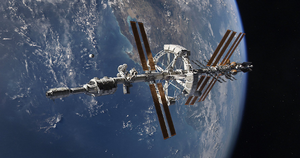Courage Spacecraft: Difference between revisions
No edit summary |
No edit summary |
||
| Line 1: | Line 1: | ||
[[File:CourageSpacecraft.png|thumb|right|The [[Courage Spacecraft]] in orbit over [[Iearth]] prior to the Courage 1 journey, as seen from the [[Coalition Space Station]] on June 7th, 2021]] | [[File:CourageSpacecraft.png|thumb|right|The [[Courage Spacecraft]] in orbit over [[Iearth]] prior to the Courage 1 journey, as seen from the [[Coalition Space Station]] on June 7th, 2021]] | ||
The '''Courage Spacecraft''', the result of a decade-long collaboration between the [[Zamastanian Space Agency|ZSA]], [[Cosmic Travel Administration|CTA]], [[Yuan Space Exploration Initiative|YSEI]], [[Drambenburg Zentrum fur Luft-und Raumfahrt|DLR]], and [[Beleroskov Exploration of Space Agency|BESA]], is the crew transport spacecraft of the [[Courage program]], built to transport astronauts from [[Iearth]] to [[Eirus]] orbit and back. It is the most complex | The '''Courage Spacecraft''', the result of a decade-long collaboration between the [[Zamastanian Space Agency|ZSA]], [[Cosmic Travel Administration|CTA]], [[Yuan Space Exploration Initiative|YSEI]], [[Drambenburg Zentrum fur Luft-und Raumfahrt|DLR]], and [[Beleroskov Exploration of Space Agency|BESA]], is the crew transport spacecraft of the [[Courage program]], built to transport astronauts from [[Iearth]] to [[Eirus]] orbit and back. It is one of the most expensive and complex objects that the world has ever constructed. | ||
The Blue Eagle rocket transports the astronauts from the [[Tregueux International Space Center|International Space Center]] at [[Tregueux]] to the [[Courage Spacecraft]]. The Courage Spacecraft was constructed in modules, launched and fitted together in low-orbit. The process took more than 10 years alongside the construction of the Coalition Space Station, but as each module was fitted it became regular and more adapted to routine as a new vessel could be assembled with modules entirely within seven months. The spacecraft is composed of two primary habitable zones. Albatross Multi-Purpose Crew Vehicle (MPCV) is intended to serve as the launch/splashdown crew delivery vehicle, with a Deep Space Habitat module providing additional living-space for the 7-month-long journey. | The Blue Eagle rocket transports the astronauts from the [[Tregueux International Space Center|International Space Center]] at [[Tregueux]] to the [[Courage Spacecraft]]. The Courage Spacecraft was constructed in modules, launched and fitted together in low-orbit. The process took more than 10 years alongside the construction of the Coalition Space Station, but as each module was fitted it became regular and more adapted to routine as a new vessel could be assembled with modules entirely within seven months. The spacecraft is composed of two primary habitable zones. Albatross Multi-Purpose Crew Vehicle (MPCV) is intended to serve as the launch/splashdown crew delivery vehicle, with a Deep Space Habitat module providing additional living-space for the 7-month-long journey. | ||
Electrical power on Courage is provided by its onboard nuclear reactor as well as its solar panels. While aboard, Courage's rotating gravity segment generates a degree of artificial gravity to allow the astronauts ease of mobility and to maintain sufficient muscle tone in space, protecting them from the effects of long-term weightlessness. Courage is also equipped with photon radiation shielding to insulate the spacecraft from solar and cosmic radiation (which can cause cell damage and cancer) as well as an array of advanced life support systems such as its oxygenator and water reclamation processors which allow it to sustain human life for extended durations. Essentially, the spacecraft is an expanded version of the Coalition Space Station, having taken all equipment reference from the CSS and replicated it for the Courage | Electrical power on Courage is provided by its onboard nuclear reactor as well as its solar panels. While aboard, Courage's rotating gravity segment generates a degree of artificial gravity to allow the astronauts ease of mobility and to maintain sufficient muscle tone in space, protecting them from the effects of long-term weightlessness. Courage is also equipped with photon radiation shielding to insulate the spacecraft from solar and cosmic radiation (which can cause cell damage and cancer) as well as an array of advanced life support systems such as its oxygenator and water reclamation processors which allow it to sustain human life for extended durations. Essentially, the spacecraft is an expanded version of the Coalition Space Station, having taken all equipment reference from the CSS and replicated it for the Courage. | ||
==History== | ==History== | ||
Revision as of 05:20, 9 January 2024

The Courage Spacecraft, the result of a decade-long collaboration between the ZSA, CTA, YSEI, DLR, and BESA, is the crew transport spacecraft of the Courage program, built to transport astronauts from Iearth to Eirus orbit and back. It is one of the most expensive and complex objects that the world has ever constructed.
The Blue Eagle rocket transports the astronauts from the International Space Center at Tregueux to the Courage Spacecraft. The Courage Spacecraft was constructed in modules, launched and fitted together in low-orbit. The process took more than 10 years alongside the construction of the Coalition Space Station, but as each module was fitted it became regular and more adapted to routine as a new vessel could be assembled with modules entirely within seven months. The spacecraft is composed of two primary habitable zones. Albatross Multi-Purpose Crew Vehicle (MPCV) is intended to serve as the launch/splashdown crew delivery vehicle, with a Deep Space Habitat module providing additional living-space for the 7-month-long journey.
Electrical power on Courage is provided by its onboard nuclear reactor as well as its solar panels. While aboard, Courage's rotating gravity segment generates a degree of artificial gravity to allow the astronauts ease of mobility and to maintain sufficient muscle tone in space, protecting them from the effects of long-term weightlessness. Courage is also equipped with photon radiation shielding to insulate the spacecraft from solar and cosmic radiation (which can cause cell damage and cancer) as well as an array of advanced life support systems such as its oxygenator and water reclamation processors which allow it to sustain human life for extended durations. Essentially, the spacecraft is an expanded version of the Coalition Space Station, having taken all equipment reference from the CSS and replicated it for the Courage.